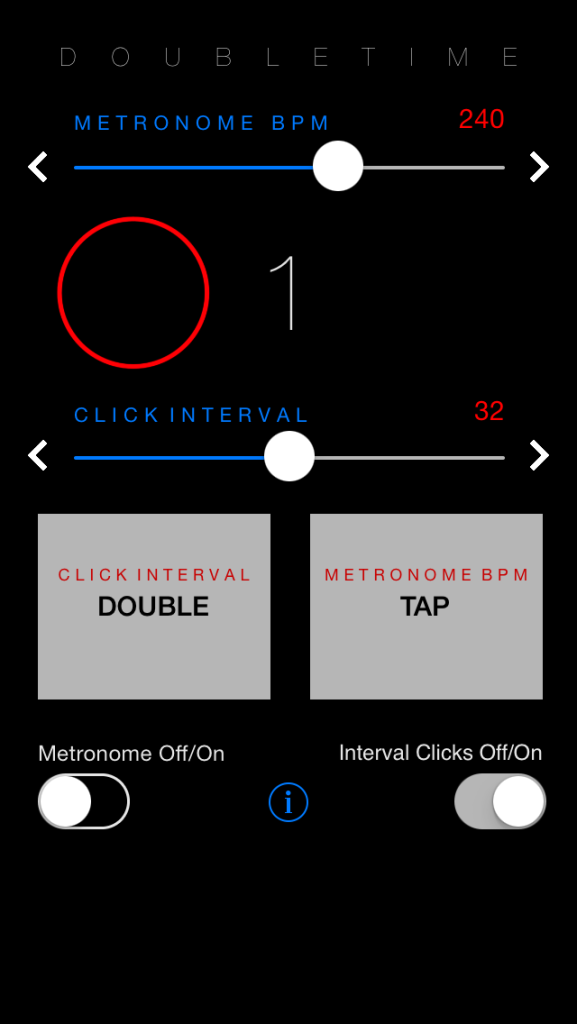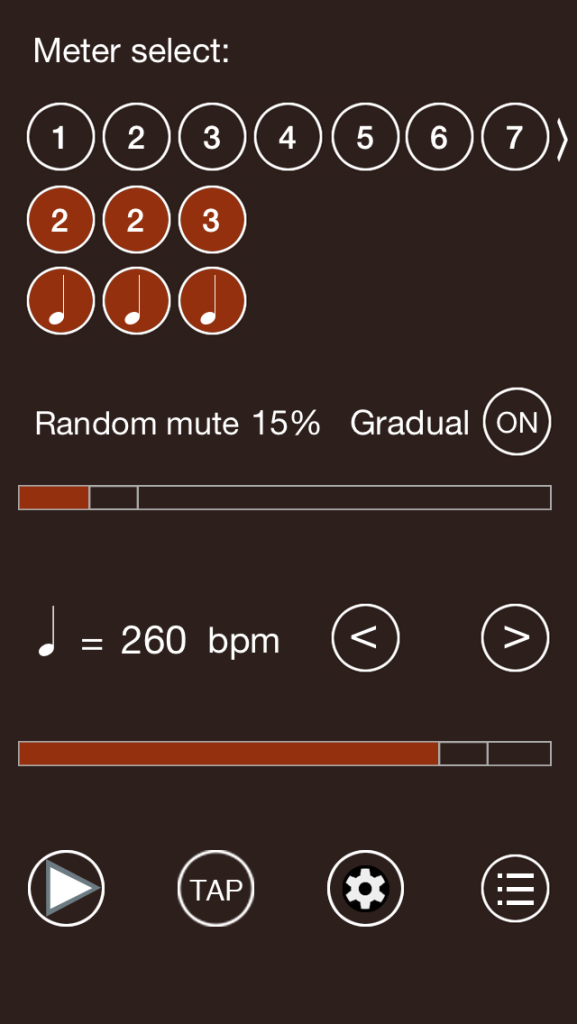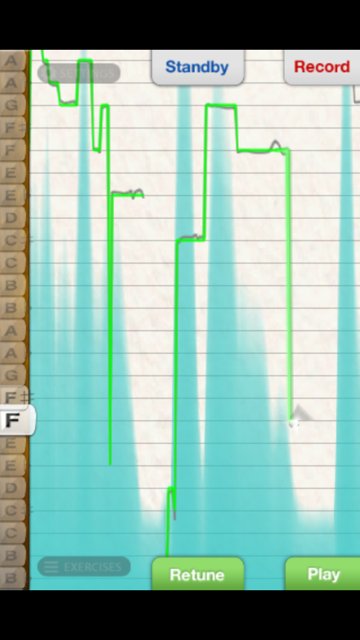 As some of you may be aware, my day job is in mobile app software development. So, when I come across useful, intuitive apps that actually help me solve real problems that I face as a musician, I get really excited!
As some of you may be aware, my day job is in mobile app software development. So, when I come across useful, intuitive apps that actually help me solve real problems that I face as a musician, I get really excited!
I’ve been using Pitch Primer and Time Guru with some regularity for over a year now. I recently also came across Double Time, and let’s just say it’s revealing glaring issues in my time, which you will witness for yourself below. These apps might not win any design awards, but the highly specialized utility they offer makes them invaluable practice tools.
Let’s go through each of these three iPhone apps, and along the way I’ll demonstrate how and why I use them in my quest to become a better musician.
Sorry Android users, only Time Guru offers an Android version, but please, don’t even get me started with the follies of Android…
DoubleTime
 As I said above, this one is relatively new to me. Developed by fantastic jazz pianist Dan Tepfer, DoubleTime‘s basic premise is that you can learn to feel the groove by incrementally spacing out metronome clicks. That’s the app’s killer feature – a big button that says DOUBLE – allowing you to easily “double” metronome click intervals with a single tap, so you don’t miss a step. It’s so simple, yet so brilliant. Dan is a wonderful solo/duo player, so if this is the process he’s using to improve his internal rhythm, there must be something to it!
As I said above, this one is relatively new to me. Developed by fantastic jazz pianist Dan Tepfer, DoubleTime‘s basic premise is that you can learn to feel the groove by incrementally spacing out metronome clicks. That’s the app’s killer feature – a big button that says DOUBLE – allowing you to easily “double” metronome click intervals with a single tap, so you don’t miss a step. It’s so simple, yet so brilliant. Dan is a wonderful solo/duo player, so if this is the process he’s using to improve his internal rhythm, there must be something to it!
In the example below, I improvise over the standard All The Things You Are at quarter note = 240bpm. I’ll start with clicks on beat 1 of 4 (clicks every 60BPM = one second) and begin to play the tune. Each chorus, I hit the DOUBLE button. Here’s a play-by-play of the embarrassment that ensues:
- 1st Chorus (click every 1 measure/second): I feel pretty good, my lines flow somewhat naturally, and all is well. Then I hit double…
- 2nd Chorus (click every 2 measures/seconds): My lines become more unimaginative as I’m focusing on keeping the groove. I begin to rush over the bridge, and I’m a bit off.
- 3rd Chorus (click every 2 measures/seconds again): Since I wasn’t feeling locked into the time during chorus 2, I took another chorus to settle in. I begin by completely missing an altissimo thing I’m going for, c’est la vie. At least my time is slightly better, and I’ve internalized the groove just a bit more.
- 4th Chorus (click every 4 measures/seconds): I get slightly off around the bridge again, but by the end of the chorus I’m feeling the groove more deeply. Time for another double!
- 5th Chorus (click every 8 measures/seconds): I’m not nailing the metronome clicks as they swing by, but I get a bit lucky with a few that line up well. I’m feeling adventurous by the end of this chorus, so I’ll hit DOUBLE again just for fun.
- 6th Chorus (click every 16 measures/seconds): Disaster. Now I’m starting to guess at when that little metronome click is going to chime in, and you can hear everything break down. To be fair, that’s fewer than 4 clicks per minute! By the end, I’m just lost…
Dan says “doing this exercise well requires you to relax,” so clearly I need to work on chilling out.
Time Guru
 Like DoubleTime, Time Guru is another fancy metronome. And like DoubleTime, the app also packs a killer feature that will test how deeply you feel a groove: Random mute!
Like DoubleTime, Time Guru is another fancy metronome. And like DoubleTime, the app also packs a killer feature that will test how deeply you feel a groove: Random mute!
Here’s how the app works:
- Set up a groove. This takes a bit of getting used to, but you can create metronomic beats that consist of different meters and note values. In the screenshot to the right, I created a very simple beat in 7/4 time consisting of 2 sets of 2-beat quarter notes (first strong, second weak) plus 1 set of 3 beat quarter notes (1 strong, 2 weak).
- Choose Random Mute %: A slider allows you to control the probability that each click in the beat you created in step one will be muted. Set it to 0% and all notes will play, set it to 100% and everything will be muted. I chose 15% in this example for just a bit of random muting (you can hear it start to mute the beat around 15 seconds into the example video).
- Gradual Muting? To allow you to establish the groove before random mute starts kicking in, you can turn “gradual” on to start with 0% muting, then slowly start to mute clicks until you reach your desired level of Random Mute. This is actually quite similar to what you will encounter in real-life playing situations: most guys will set the time with something solid before they will start messing around with it.
- Pick your tempo. Set your desired BPM.
There are other features, like editing your sound, saving specific grooves, and tapping to start, but they aren’t creating the real value here. The app is perfect for working on odd time signatures. You’ll find that the random muting will really throw you off the groove if you become too dependent on each and every click to create your internal pulse. After all, it’s not just the drummer that sets the time, it’s everybody’s responsibility.
Here’s me trying my hand at a simple 7/4 groove with a bit of random muting, just playing around with my E7(b9 b13). Sorry about the distorted audio in the video 🙁
Pitch Primer
 I’ve always be frustrated with tuners. Yes, I can hold out a long tone and it will tell me exactly how many cents sharp or flat I am in relative real-time. However, whether I’m in tune when playing a moving line has always been something of a mystery.
I’ve always be frustrated with tuners. Yes, I can hold out a long tone and it will tell me exactly how many cents sharp or flat I am in relative real-time. However, whether I’m in tune when playing a moving line has always been something of a mystery.
Enter Pitch Primer. This app hasn’t been touched in almost 6 years, and, relative to the rest of the app store, it will cost you a whopping $9.99. But if you’re serious about improving your intonation, this is worth every penny.
Now before I dive in too deep, I want step back for a minute and address absolute versus relative pitch. Relative pitch means you are able to play in tune with others. You learn to play slightly flatter when playing the third degree of a major chord, and you will match pitch with whatever intonation is being played around you. This is an invaluable skill, but it is not enough.
With pitch primer, you will learn to have great absolute pitch. This means that when you play alone, your attempt at playing A440 is very close to A440 (translation – your standard tuner says you’re in tune). And you will become better at playing that A close to 440 whether you are holding a note or playing it as a part of a moving line.
Here’s what makes this app better than a standard tuner:
- Moving Notes: It provides your intonation relative to a baseline in real time for each and every note, from start to finish.
- Review: when you are done playing your line, it knows you’ve stopped playing and automatically plays your line back to you, graphing your pitch against the in-tune pitch.
- Beginnings and Endings: You can see your tendencies – do you go sharp at the end of a note? Of a line? What happens when you use vibrato?
There’s almost no learning curve with this app, and you will see value immediately. One thing to ignore is the “Retune” feature, which basically makes your playing sound like T-Pain. Funny, yes, but useful? Probably not. Some features that more tonally exotic users will appreciate are the ability to adjust calibration (set it to A444, etc.) and temperament (Equal, Just Intonation, Pythagorean, Meantone) with Root and Scale settings to match.
Watch me play a bit of the head to Confirmation, noodle around for a minute with different bends and such, then cringe at the replay:
Conclusion
With the above 3 apps, you’ll be on your way to establishing a solid intonation baseline, always being your own timekeeper, and seriously grooving to the music.

Currently listening to Mockroot, by Tigran Hamasyan
